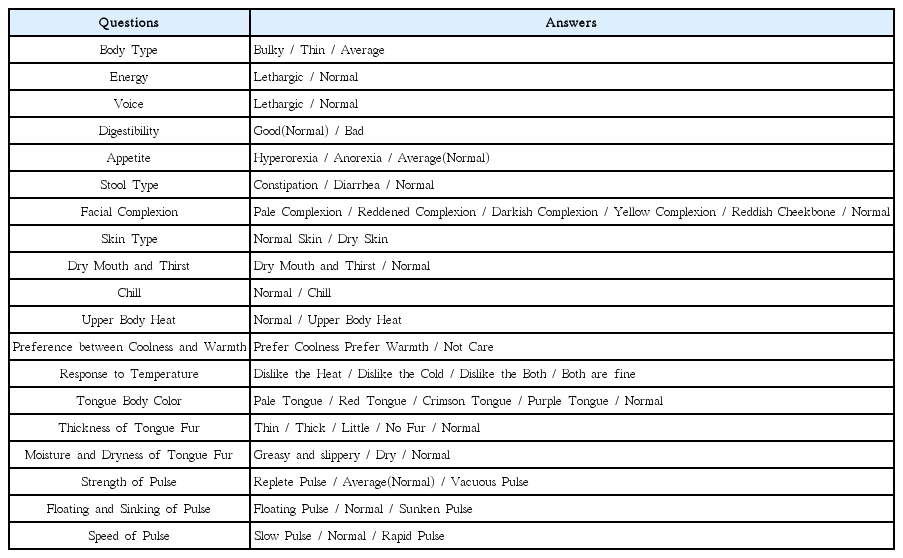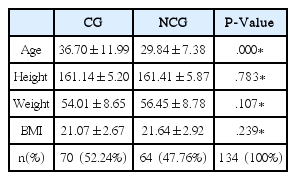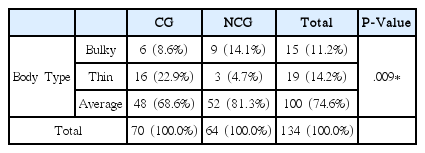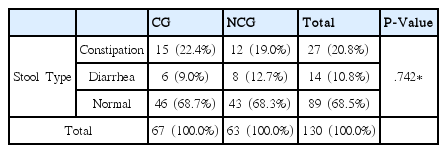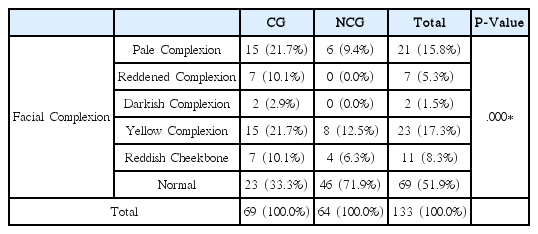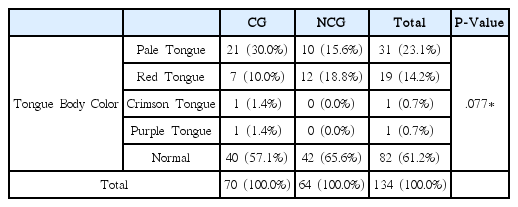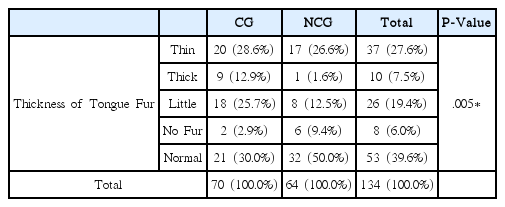References
1. Lee SL, Lee KS, Song BK. Literature survey on women’s syndromes due to cold. J Korean Obstet Gynecol 1996;9(1):55–80.
2. Yamamoto I. Treatment and background of coldness(1). Journal of Kampo Medicine 1976;23:259–65.
3. Hong WS. Jeonggyohwangjenaegyeongsomun Seoul: Oriental Medicine Laboratory; 1981. p. 169–72.
p. 245.
4. Kim CM. Diagnosis and treatment of cold hands/feet syndrome. Korean Journal of Family Medicine 2004;25(11):273–7.
5. The Society of Korean Medicine Obstetrics and Gynecology. Oriental Obstetrics & Gynecology 2 Seoul: Eui Seong Dang Publishing Co; 2012. p. 888–94.
6. Kim DH, Kim YS, Lee GS. Standardization of diagnosis of cold hypersensitivity of hands and feet by D.I.T.I. The Journal Of Oriental Gynecology 2001;14(2):129–34.
7. Bae GM, Cho HS, Kim KK, Lee IS. Research of relationship on cold hypersensitivity for the patients in OB&GY of Dong Eui medical center. J Korean Obstet Gynecol 2002;15(2):101–13.
8. Compilation board of dictionary of Korean medicine. Dictionary of Korean medicine Seoul: Jungdam; 2010. p. 312.
9. Park JY, Leem JT, Park SK, Woo SK, Kwak SH, Jung WS, et al. The between Coldness of Hands and Feet and the Erythrocyte Deformability in Stroke Patients. Korean J Orient lnt Med 2010;31(3):578–85.
10. Jang KH, Song HS, Lee DK, Kim S, Kim SW. A Study of Association between Cold Hypersensitivity and Orthostatic Hypotension(OH). Jof Oriental Medical Thermology 2003;2(1):29–3.
11. Yu JS. Distribution of Sasang Constitution and Prescriptions of Patients with Coldness in Hands and Feet. J Sasang Constitut Med 2016;28(3):225–32.
12. Ko SW, Park JJ, Kong KH, Go HY. Diagnostic Tool for Cold Sensation of Hands: A Preliminary Study. J Int Korean Med 2015;36(3):228–35.
13. Han JY, Joe JH, Jang JB, Kim YS, Lee KS. Cold Stress Test for The Diagnosis of Cold Hypersensitivity on Hands. J of Oriental Medical Thermology 2003;2(1):17–23.
14. Lee KS. A Clinical Evaluation of DITI and Neurometer for the Diagnosis of Cold Hypersensitivity. J of Oriental Medical Thermology 2004;3(1):60–6.
15. Lee MJ, Kim EK, Lee JM, Cho JH, Jang JB, Lee KS, et al. Analysis of Heart Rate Variability in Cold Hypersensitivity Females Visiting Gangnam Hyung-Hee Korean Hospital. The Journal of Oriental Obstetrics & Gynecology 2011;24(3):109–15.
16. Choi JH, Kim ES, Hwang JH, Lee JM, Lee CH, Cho JH, et al. A clinical study on patients with Cold Hypersensitivity on hands and feet and their autonomic nervous system function using of Heart Rate Variability(HRV). J of oriental medical thermology 2006;5(1):1–13.
17. Yang YS, Masayaseu Gachita. Korean medicine treatment for Coldness Sterility Obsesity Seoul: Gugil Media; 2002. p. 75–82.
18. Kwon Y. Health book for home written by Korean medicine doctor Seoul: Healty life; 2003. p. 26–40.
19. Jae IS. Sanghallonyeokjeon Seoul: Gomunsa; 1991. p. 238–9.
20. Moon JJ. Sanghallonjeonghae Seoul: Kyunghee University Publication; 1996. 568p. 608.
21. Woo HL, Park YK, Kim JH, Park KS, Hwang DS, Lee JM, et al. Study on the Correlation between Digital Infrared Thermal Imaging-induced Severity of Cold Hypersensitivity of Hands and Feet and Heart Rate Variability. J Korean Obstet Gynecol 2016;29(3):1–9.
22. Bea GM, Cho HS, Kim KK, Lee IS. Research of relationship on cold hypersensitivity for the patients in OB&GY of Dong Eui Medical center. The Journal of Oriental Obstetrics & Gynecology 2002;15(2):101–13.
23. Kim SJ, Lee SW, Lee YS. A Study on the Difference of Cold-heat Patterns between Health and Mibyeong Group. Journal of Society of Preventive Korean Medicine 2017;21(1):49–56.
24. Kim JH, Ku BC, Kim JE, Kim YS, Kim KH. Study on Reliability and Validity of the ‘Qi Blood Yin Yang Deficiency Questionnaire’. Korean J Oriental Physiology & Pathology 2014;28(3):346–54.
25. Kang BK, Heo TY, Yun KJ, Park TY, Lee JA, You SS, et al. Study II of Diagnosis Criteria for Qi deficiency in Stroke. Korean JOriental Physiology & Pathology 2014;28(1):76–81.
26. You KW. Biwiimsanghak Seoul: Traditional Medicine Laboratory; 1993. p. 116–29.
27. Lee AR, Kim WI. The Retrospective Comparative Study of General Acupuncture Therapy and Hominis placenta Pharmacopuncture Therapy on Severe Dyspepsia. Korean Journal of Acupuncture 2013;30(4):319–28.
28. Han GJ, Kim JS, Park JW, Ryu BH. Pattern Identification of 97 Functional Dyspepsia Patients and the Characteristics of Each Pattern Type. J Korean Oriental Med 2011;32(2):42–62.
29. Lee BK. Korean Medicine Diagnosis Seongnam: Seongbosa; 2012. p. 70–95.
30. Kong JH. Susebowon Debuk: Goengeopseogu-kyuhangongsa; 1615. p. 249–52.
31. Danpawongyeon. Japbyeonggwangyo Seoul: Seongbosa; 1986. p. 49–54.
32. Chi SY, Lee MJ, Kim EK, Lee JM, Lee CH, Jang JB, et al. A Study on the Correlation of Cold Hypersensitivity and Common Health Indexes in Young Women. The Journal of Korean Obsterics & Gynecology 2011;24(4):62–70.
33. Yoon SW, Ha JY, Lee KS. Clinical Research about the Correlation between Defecation Type and Cold Hypersensitivity of Lower Abdomen, Hand and Foot. Journal of oriental medical thermology 2004;17(2):130–7.
34. Park JJ, Lee MS, Kong KH, Ko HY. Relationship between Heart Rate Variability and Cold-Heat Patternization in Patient with Chronic Constipation. Korean J Orient Int Med 2012;33(2):209–21.
35. Baek TS, Park YJ, Park YB, Park JH, Im JJ. Health Test for Searching of Correlation and the Index of the Cold-heat Patternization Comparison of the Questionnaires for the Cold-heat Patternization and the Ordinary. The Journal of The Korea Institute of Oriental Medical Diagnostics 2005;9(2):145–52.
36. Bae NS, Park YJ, Oh HS, Park YB. Preceding Studies for Questionnaires on Han-Yol Patternixation. The Journal of The Korean Institute of Oriental Medical Diagnostics 2005;9(1):98–111.
37. Park SW, Nam DH. A Survey on Utilixation of Questionnaires for Assessing Statues of Yin Deficiency Syndrome. The Journal of the Society of Korean Medicine Diagnostics 2014;18(2):63–74.
38. Korean Society Of Oriental Medical Physiology. Oriental Medical Physiology Seoul: Kyunghee University Publication; 1993. p. 84.
39. Department of Pathology. Nationwide College of Korean Medicine. Korean Medicine Pathology Seoul: Iljungsa; 2002. 33p. 163. p. 164.
40. Yangryeok. Junguijilbyeongyecheukhak Seoul: Beopin Munhwasa; 2001. p. 250–64.
41. Son JY, Kim JS. Diagnostic Values of Tongue Coating Thickness and Sterno-costal Angle in Functional Dyspepsia. J Int Korean Med 2014;35(2):157–74.
42. Bae SC. Geumseok Hwangjenaegyeongsomun Seoul: Seongbosa; 1995. p. 20–168.
43. Department of Pathology, Nationwide College of Korean Medicine. Korean Medicine Pathology Seoul: Hanui Munhwasa; 2007. p. 323–24.
44. Park MS, Kim YM. Study on Clinical Disease of Qi Deficiency Pattern. Korean J Oriental Physiology & Pathology 2013;27(5):487–96.
45. Lee NM. China Seoljindaejeon Beijing: Won Publisher; 1995. p. 24.
46. Park MS, Kim YM. Study on Clinical Disease of Yang Deficiency Pattern. Korean J Oriental Physiology & Pathology 2013;27(2):153–66.

